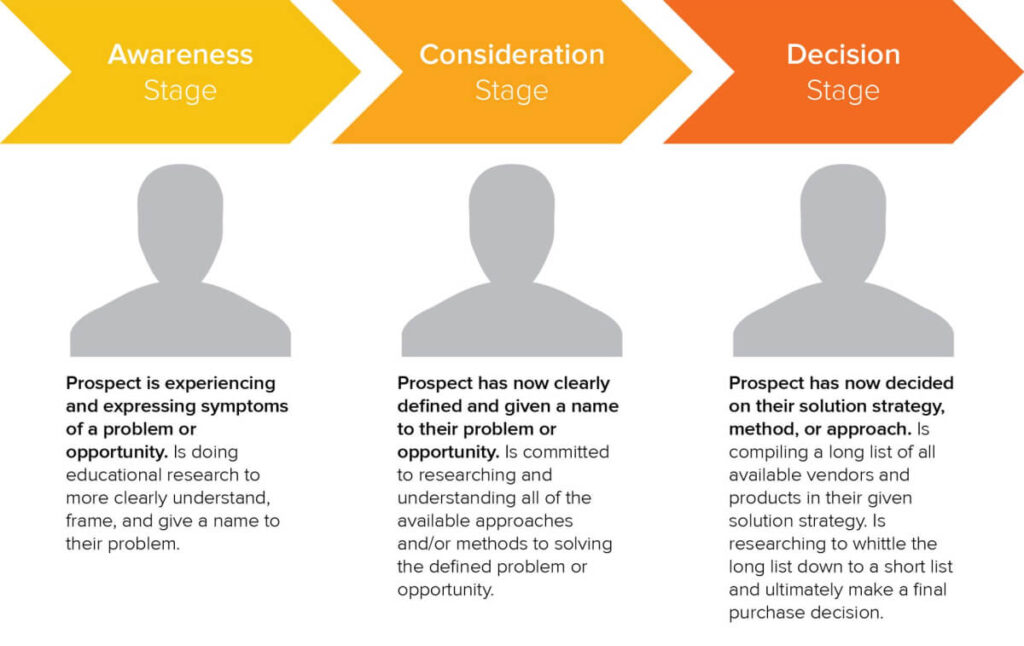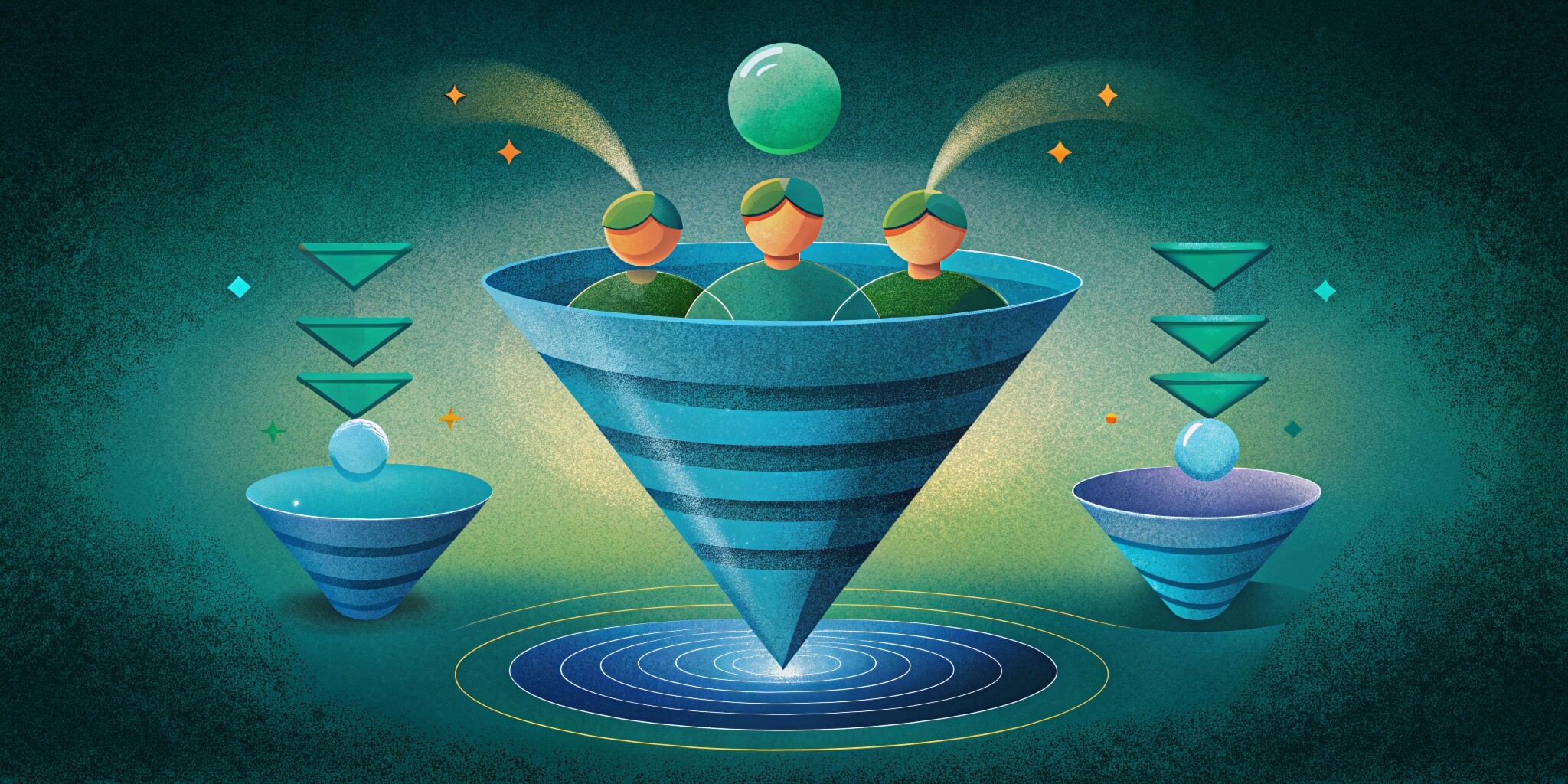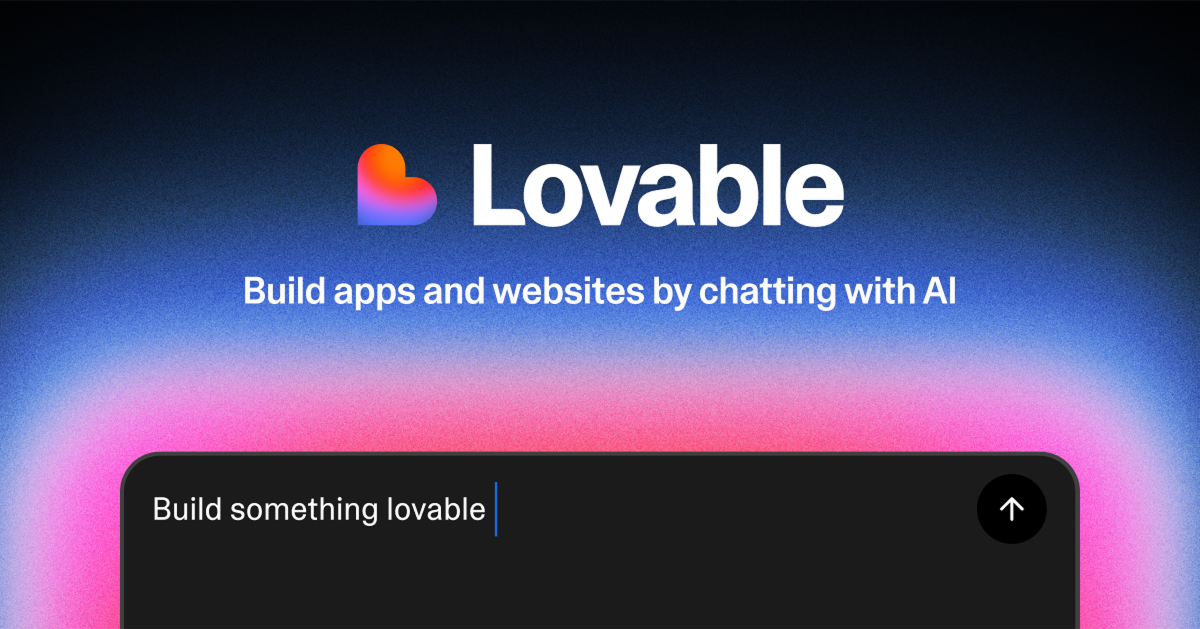Understanding the different lead types and their needs is the key to creating a well-performing funnel.
In fact, 67% of lost sales are a result of marketers not properly identifying their potential customers before taking them down through the sales funnel.
If you want to move prospects from interested to paying customers you’ll need to map the customer’s journey and create fitting content for every stage.
In this article, I’ll help you identify the three main stages of the sales funnel and give you some ideas on what type of content you should implement in every stage to boost your sales.
Let’s get started.
Mapping the Customer Journey
Here’s a simplified illustration of the customer journey.

It’s important to remember that the modern customer journey is not linear and prospects can enter your funnel at any stage.
Awareness Stage
In the awareness stage, your prospects are trying to solve a problem, find an answer, or meet a need.
At this point, buyers have little understanding of the things they can do to meet that need or solve that problem, so they are looking for resources and information.
They are unable to make decisions about what type of products they should purchase to fix their problems.
The goal at this stage is to provide them with as much upfront value as possible by using top-level educational content which will direct them toward a solution.
Keep in mind that sales pressure and techniques like FOMO (fear of missing out) won’t function at this stage of the funnel.
Instead, you should be focused on nurturing prospects by providing them with high-quality blog posts, articles, and ebooks. This type of content will direct leads toward the consideration stage.
Consideration Stage
Once a lead is past the awareness phase, they enter the consideration stage.
At this point, you’ve managed to attract a lead’s attention and they are interested in learning more about what your company has to offer.
However, they’re in an evaluating phase and still not prepared to make a purchase. Keep in mind that at this particular point, leads are looking for the best solution to their problem.
While you should prospect with top educational content at the top of the funnel. This is the stage where you need to show them why your services or products are the right solutions for them.
Your goal at this point is to create an image for your prospects on what life would be like if they accept your solutions to their problems. Keep the focus on their returns and what they can expect to gain if they decide to invest in your services.
A good way to ease them to the next stage of the funnel is to provide them with free trials, discounts, and videos.
This phase requires extended engagement as the investment is low on the lead’s end. Your prospects are still not committed, so establishing trust between them and your brand is vital.
Purchase Stage
After the extended phase of nurturing your leads down the funnel, this is the point where they’re finally ready to make the purchase decision.
However, this still doesn’t mean that they’re going to choose your solutions.
This is the final choice a lead needs to make: Which is the best solution to their problem?
Usually, leads at the bottom of the funnel are prepared to pull the trigger and just one compelling call-to-action can get them to purchase your product. The right call-to-action, offer, and type of content you use at this stage will have a crucial impact on your conversions.
However, the goal at this stage isn’t just to press leads to make a purchase. You should also provide them with educational materials on how to incorporate the new solution into their lives.
By doing this you’ll show that you care about their successes with your product and services.
Content Ideas for Each Stage in the Funnel
Content Ideas for the Awareness Stage
According to Pymnts, 88% of consumers pre-research their buys online before making a purchase. The chances are that your leads also fall into that category.
Keep in mind that at this point people are in an information-gathering stage and it is likely that the product or service that will catch their attention will be the one produced by a brand that delivers high-quality content.
This content should be informative, but also fun and interesting.
To catch leads’ attention at this point, invest in optimized high-value content like:
- Blog posts
- eBooks
- White papers
Independent and original research also scores high at this point.
However, don’t just stick to written content. To stand out in a crowded market place, you’ll also need infographics, videos, and social media content.
Content Ideas for the Consideration Stage
The middle funnel is the stage where prospects start evaluating and eliminating solutions. So, although high-quality content will attract prospects at the top of the funnel, this type of content lacks the ability to nurture leads down the funnel.
Surprisingly, a recent study found that 68% of B2B companies haven’t identified their sales funnel. Without a clearly defined sales funnel, you won’t be able to determine where leads are in the buying process. This means that you can’t possibly nurture leads and move them further down the funnel.
Leads at this point are looking for experts in the industry and you’ll need to demonstrate that you’re an expert by providing them with engaging content.
The most effective types of content at this point are:
- Webinars.
- Expert guides.
- Live interactions that prove the benefits of your services.
It’s also important to track clicks in your email campaigns and follow which posts on social media platforms boost engagement to better understand what type of solutions your prospects are seeking.
As mentioned above, at this point it is very important to position yourself as an expert in the field. However, only a helpful expert will properly nurture leads down the funnel. Although these leads are not yet ready to make a purchase, you need to answer their questions and provide additional information.
A recent study found that 65% of B2B marketers haven’t established lead nurturing. Be sure to avoid this mistake and position yourself as a trusted advisor.
Market2Lead analyzed their customers’ data and compared nurtured vs. non-nurtured leads. They found that nurtured leads have a 23% shorter sales cycle.
Content Ideas for the Purchase Stage
If you analyze the most common type of marketing content, you’ll find that content suitable for the purchasing stage is all over the internet.
Websites are bursting with calls-to-action, downloads, demos, and trial offers – despite the fact that the majority of leads are not even close to making a purchase.
In fact, Marketing Sherpa found that 61% of B2B marketers send all leads directly to sales, although only 27% of those leads will be qualified.
It’s important to understand that it is very unlikely that the bottom-of-the-funnel content will turn a prospect into a customer. You need to create proper content for the whole buyer’s journey.
The compelling nature of the final offer will be created only if your content is mapped appropriately to the buyer’s journey. This means that your content needs to develop appropriately for every stage.
In the final stage, the most effective types of content are:
- Demos
- Special offers
- Case studies
- Product implementation

